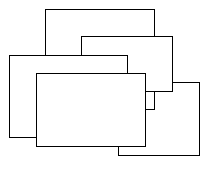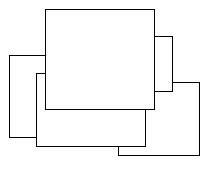(This assignment was prepared by Mike Clancy and Kathy Yelick for use
in U.C. Berkeley's CS 61B, "Data Structures", in spring 2001.)
Goals
This assignment generalizes list processing techniques to lists of lists.
It will also give you practice with the LinkedList
class in the Java 2 library and familiarize you with techniques used in window managers.
Background
The directory
~cs61b/hw/hw4
contains six files:
CS61BWindow.java
,
Region.java
, and
Square.java
, plus
HW4Tester.java
,
RegionStack.fw.java
, and
SquareList.fw.java
. ("Fw" stands for "framework".) A
CS61BWindow
object is a window that maintains a list of regions displayed within it. Each region in the window is rectangular. A window may contain any number of regions, and they may overlap; overlapping regions form a sort of stack, stored in a
RegionStack
object, as shown below.
|
|
|
|
a stack of regions
|
the result of clicking on the fourth region
down from the top
|
Regions respond to mouse clicks; the clicked-on region moves to the top of the stack,
as shown in the diagram.
Each Region object may contain colored squares, stored in a
SquareList
object. One may draw a square in a region by clicking in the region somewhere
that's not already occupied by a square. One may remove a square from a region
by clicking on the square. Thus each region is associated with a list of squares
to be drawn in the region.
CS61BWindow
,
RegionStack
,
Region
, and
Square
objects draw themselves using a
paint
method. The
CS61BWindow
paint
method is called when a region in the window changes or when the window is exposed by moving another window from in front of it. It ask its
RegionList
for regions, starting with the bottom region and ending with the top, and calls each region's
paint
method. Regions in turn call the
paint
methods of their squares. The regions in the window's stack are each drawn with a border, and filled with white ink so they aren't transparent. The squares in the region are drawn (in any order) when the region is drawn, each with a border. All squares in a region are drawn in the same color, a color associated with the region (thus different regions may be associated with different colors)
Clicking any of the mouse buttons in a region should do the following:
-
the region is moved to the top of the stack;
-
if the mouse was clicked on one or more squares in the region, all those squares are removed from the region;
-
otherwise, a square centered at the mouse click is added to the region.
In either case, the window is redrawn. Clicking in the window in a position not occupied by a region should have no effect.
Squares are normally 20 pixels wide and 20 pixels high.
However, they may be smaller if near the border of a region,
since they do not extend beyond the region that contains them.
Thus when a square is created, its dimensions are reduced if necessary
to make it fit within the region.
(This is an organizational flaw;
a real window manager would intercept calls that draw outside a region and avoid the overflow.)
Problem
You are to provide the two collection classes
RegionStack
and
SquareList
, plus an expanded version of the
HW4Tester
class.
RegionStack
includes the a zero-argument constructor and the following public methods, all called from
CS61BWindow
:
-
add
, which adds a region to the top of the stack;
-
handleClick
, which, given the
x
and
y
coordinates of a mouse click, processes the click as described above; and
-
regions
, which returns a bottom-to-top iterator of regions from the stack.
SquareList
includes a zero-argument constructor and the following public methods, all called from
Region
:
-
add
, which adds a square to the list;
-
handleClick
, which, given the
x
and
y
coordinates of a mouse click, either removes all squares that contain the given point from the list and returns
true
, or returns
false
if no squares contain the given point; and
-
elements
, which returns an iterator of squares from the list.
Miscellaneous requirements
You are to use the class
java.util.LinkedList
(not available in Java 1.1) as the underlying data structure for
RegionStack
and
SquareList
. Identifying the methods for this class will require some research on your part, an intended goal of this assignment.
You may add private data or methods to
RegionStack
and
SquareList
, but you are not to change the public interface. You are not to change the
CS61BWindow
,
Region
, or
Square
classes. You should add more comprehensive tests to
HW4Tester.java
; calls to the
CS61BWindow
simulateClick
method provide a way to automate the testing.
All calls to methods in the Java Abstract Window Toolkit are supplied in the framework code. Don't add any other AWT calls. (It's possible to represent the regions and squares as AWT components.
Don't do this. This is a data structures course, not an AWT course.)
All classes except
HW4Tester
include a public static boolean variable named
DEBUGGING
that can be set from outside the class to turn on debugging output.
HW4Tester.java
contains code to set these debugging switches according to an argument typed on the
java
command line after the class name:
- r sets the Region switch;
- s sets the Square switch;
- w sets the CS61BWindow switch;
- k (for "stack") sets the RegionStack switch;
- l (for "list") sets the SquareList switch.
For example, the command
java HW4Tester wkr
turns on debugging output for the CS61BWindow, RegionStack, and Region
classes. The debugging switches for RegionStack and SquareList
, if turned on, should cause output to be produced on
System.out about any change to the stack/list.
You should include an overview comment with each class and accompany your methods
with comments that describe their arguments, side effects, and pre- and postconditions.
The
README
file
Include in your submission a file named README. The contents of the README file should include the following:
-
Estimates of the running time of the operations performed on your
RegionStack
and
SquareList
objects. Assume for these estimates that the
CS61BWindow
contains
n
regions. Then give, and briefly justify, a big-Oh estimate for the time
your program requires for each of the following:
- finding the clicked-on region, assuming it's the kth region down from the top of the stack;
- moving that region to the top of the stack;
- determining which squares were clicked on, assuming that there are m< squares in the region;
- creating an m+1-st square for the region;
- removing j clicked-on squares from among the m in the region.
The documentation for the
LinkedList
class notes that "all of the operations perform as could be expected for a doubly-linked list."
You may assume that a
LinkedList
object stores pointers to both ends of the list.
-
An annotated listing of your
HW4Tester
file, indicating for each test what evidence it provides for the correctness of your program.
An example annotation would be something like "deleting from start of list" or
"adding a square to an empty list".

